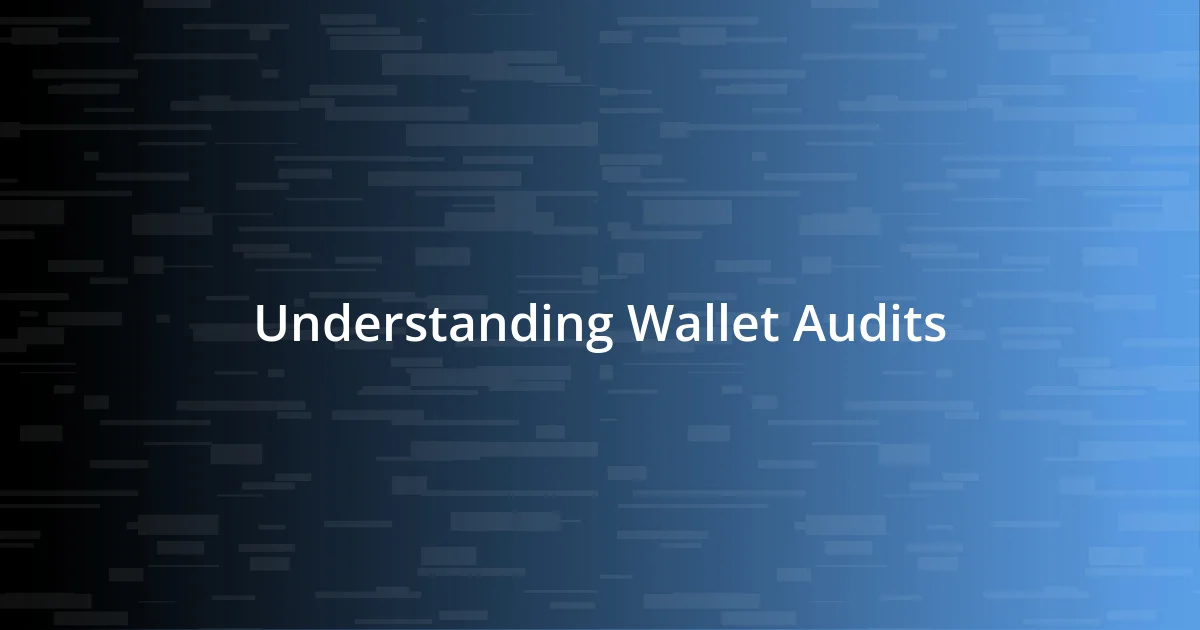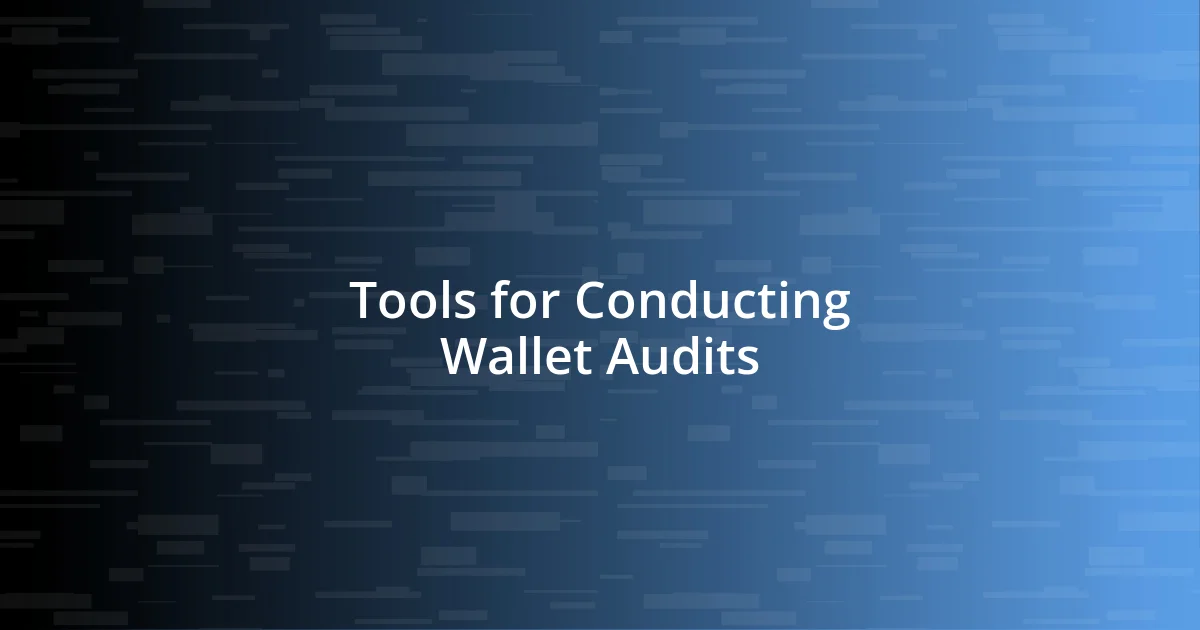Key takeaways:
- Wallet audits reveal hidden expenses, such as subscriptions and impulse purchases, shedding light on how small costs accumulate over time.
- Tracking emotional spending patterns can lead to healthier financial habits and mindful spending, ultimately aligning expenditures with personal values.
- Emerging technologies, like AI and community-led platforms, are enhancing the wallet audit process by providing tailored insights and fostering accountability among users.

Understanding Wallet Audits
When I first learned about wallet audits, I was curious yet apprehensive. The idea of scrutinizing my financial habits felt daunting, almost like shining a flashlight on my spending habits. Have you ever taken a hard look at your own financial decisions? It’s often eye-opening.
As I delved deeper into the process, I discovered that a wallet audit isn’t just about tallying expenses—it’s a reflective journey. I recall the moment I uncovered that my impulse buys on coffee added up to a small fortune over time. It made me ask myself: what truly brings value to my life? The emotional weight of those revelations can be surprising, highlighting how important it is to align spending with personal values.
Moreover, understanding wallet audits helped me develop better financial habits. I learned to categorize my expenses, which not only clarified my financial landscape but also ignited a sense of control. Have you ever felt overwhelmed by financial clutter? A structured audit can clear that fog, leading to more intentional choices in spending and saving.

Common Wallet Audit Mistakes
One of the most common mistakes in wallet audits is underestimating recurring expenses. When I first audited my wallet, I overlooked subscriptions and other regular payments that seemed harmless at first glance, but cumulatively, they were draining my budget. It was like being blindsided by a shadow; I realized that small costs quickly add up and can significantly impact my overall financial health.
Here are a few common mistakes people tend to make in wallet audits:
- Ignoring hidden fees in services or subscriptions
- Failing to account for lifestyle changes that affect spending
- Not tracking cash transactions, which often go unnoticed
- Overlooking emotional spending triggers that lead to impulsive purchases
- Neglecting to update budget categories regularly as expenses change
Each mistake can lead to an inaccurate financial picture, making it more challenging to achieve those monetary goals we set for ourselves.

Key Insights from Wallet Audits
Finding key insights during wallet audits can truly transform your financial perspective. One striking revelation I encountered was how much I underestimated the impact of small, daily expenses. For example, I used to think that skipping a $4 latte here and there wouldn’t matter much in the grand scheme of my budget. However, as I tracked my spending, I realized that these seemingly innocuous choices were adding up to over $100 a month! It was a wake-up call that showed me how conscious spending decisions could lead to saving.
An intriguing part of my wallet audit journey was analyzing my emotional spending patterns. I discovered that shopping often filled an emotional void for me, especially during stressful times. This was an ‘aha’ moment because it made me shift my focus to healthier coping strategies. Have you ever found yourself reaching for your wallet during emotional highs or lows? It’s a common pattern that can derail your financial goals if left unchecked.
Lastly, I noticed that keeping a financial journal alongside my wallet audit really heightened my awareness. I started jotting down not only amounts spent but also my feelings during those purchases. This practice not only encouraged mindfulness in my buying habits but also helped me better align my spending with my personal values. It’s become a reflective exercise that has deepened my understanding of why I spend the way I do.
| Insight | Personal Experience |
|---|---|
| Impact of Small Expenses | Skipped lattes added up to over $100 a month. |
| Emotional Spending Patterns | Shopping was a coping mechanism during stress. |
| Financial Journaling | Journaling deepened insights into my spending habits. |

Effective Wallet Management Strategies
Effective wallet management has truly reshaped the way I view my finances. One strategy that has worked wonders for me is regularly categorizing my expenses. By grouping my spending into categories like groceries, entertainment, and travel, I was able to spot trends more easily. It’s like shining a light on my financial habits; suddenly, I could identify areas where I was overspending and adjust accordingly. Have you ever considered how visualizing your spending might clarify your money management?
Another impactful approach I’ve adopted is setting specific spending limits for each category. Initially, I felt a bit restricted by this tactic, but it soon became liberating. I discovered that having a cap on my dining out expenses forced me to explore new cooking recipes at home, transforming what I once viewed as a chore into a fun experiment. Isn’t it fascinating how limitations can spark creativity in spending habits?
Engaging in a weekly review of my wallet also transformed my financial management game. Every Sunday, I take a moment to assess my transactions from the week. This practice not only helps me stay accountable but also allows me to reflect on my emotional triggers. For instance, after a long week, I often notice a tendency to splurge on takeout. Recognizing this pattern has empowered me to plan ahead and opt for a cozy homemade meal instead. How do you maintain awareness of your spending trends amidst life’s busyness?

Tools for Conducting Wallet Audits
When it comes to conducting wallet audits, I’ve found that a few specific tools can make all the difference. For starters, budgeting apps like Mint or YNAB (You Need A Budget) can break down your spending in real-time and alert you when you’re nearing your limits. I remember the first time I linked my bank accounts—it felt like switching on a light in a dark room, illuminating spending habits I hadn’t been aware of before.
Spreadsheets also became my trusted allies in this journey. I created a simple tracker that categorized my daily expenses, which made it easier to visualize where my money was going. The ease of inputting data made my tracking consistent, and I still look back at the trends I’ve charted to understand how seasonal changes in my spending occur. Have you ever noticed how your expenses can fluctuate with the seasons? I certainly have—summer often tempts me into more spontaneous outings!
Lastly, I can’t rave enough about the power of financial coaching tools that offer personalized insights. Platforms like Personal Capital provide more than just numbers; they engage you in reflecting on your financial future. When I started using such tools, I found myself pondering deeper questions about my financial goals. What’s stopping you from reaching yours? I still carry those reflections with me on my path to financial health; it’s amazing how this kind of introspection can form the basis of a more informed financial strategy.

Real-life Audit Case Studies
Reflecting on my wallet audit experiences, I recall a case where I stumbled upon unexpected savings. During an audit, I discovered a subscription I hadn’t used in months. That realization stung a bit—why had I let it slip through the cracks? Canceling that recurring expense freed up $15 a month, which I redirected toward a small savings challenge. Have you ever looked at your subscriptions and found any that were just draining your wallet?
In another instance, I analyzed my grocery spending and noticed a pattern of impulse purchases. I decided to document every item I bought for a month. The outcome was eye-opening: I realized my heartstrings were being tugged by marketing tactics. It felt like a personal defeat at times, but I began to make more conscious choices. Have you ever questioned your grocery habits and how they affect your finances?
A memorable case study was my attempt to track every dining-out experience for a month. The sheer volume of takeout orders was alarming! I found myself asking, “What drives me to eat out so much?” The answer revealed both convenience and emotional comfort—especially on busy or stressful days. By recognizing these triggers, I shifted my approach and started meal prepping on weekends, saving not just money but also precious time. Isn’t it empowering to uncover the motivations behind our spending habits?

Future Trends in Wallet Audits
Looking ahead, I see emerging technologies playing a pivotal role in wallet audits. Tools incorporating artificial intelligence (AI) will soon analyze spending habits with even greater precision. Imagine receiving real-time spending notifications tailored to your unique patterns, alerting you before habits spiral out of control. It’s exciting to think about how this could change financial awareness, isn’t it?
Moreover, I’ve noticed a growing trend toward integrated financial wellness platforms. These platforms not only focus on spending but also incorporate mental health resources, recognizing that financial and emotional well-being are deeply intertwined. I’ve always believed that understanding our feelings about money can lead to better financial decisions. It makes me wonder—how often do we stop to consider the emotional undercurrents driving our spending?
Lastly, the concept of community-led financial audits is on the rise. As people share their audit experiences online, they’re creating supportive networks that foster accountability. I vividly recall the sense of camaraderie I felt when joining an online group discussing financial challenges; it felt liberating to share and learn from others’ journeys. Have you ever participated in a community like that? I can tell you from experience that collective insights can truly amplify your own learning!












